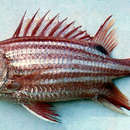Diagnostic Description
provided by Fishbase
Body with subequal stripes of brownish red and silvery white; spinous dorsal dark red with a large, quadrangular, whitish blotch in middle of each membrane (except the first) forming a median band; dorsal membrane tips white, except posteriorly (Ref. 4201). Five oblique scale rows on cheek; body depth 2.5-2.8 in SL; head length (HL) 2.65-2.85 in SL; short and blunt snout, its length 4.25-4.7 in HL; interorbital width 4.5 in HL; mouth terminal to slightly inferior, maxilla usually extending nearly to or a short distance beyond a vertical through center of eye, upper jaw length 2.5-2.75 in HL; premaxillary groove often ending above anterior edge of orbit; anterior end of nasal bone with a blunt spine; surface or medial edge of nasal bone spineless; nasal fossa usually without spinules on its edge; upper edge of 1st suborbital bone with a slightly retrorse lateral spine a short distance posterior to a vertical at front edge of eye, followed by a ridge of recumbent spinules; preopercular spine usually about 2/3 orbit diameter, 3.2-5.3 in HL; 3rd-5th dorsal spines subequal, longest in adults 1.9-2.3 in HL; 3rd anal spine 1.35-1.6 in HL (Ref. 27370).
- Recorder
- Cristina V. Garilao
Morphology
provided by Fishbase
Dorsal spines (total): 11; Dorsal soft rays (total): 12 - 14; Analspines: 4; Analsoft rays: 8 - 10
- Recorder
- Cristina V. Garilao
Trophic Strategy
provided by Fishbase
Inhabits rocky reefs and coral reefs (Refs. 9137, 9710, 58534, 58652, 127989); silty reefs or wrecks in lagoons, bays, or harbors (Ref. 27370), may occur in aggregations; also found hidden in caves and cracks of rocks during the day (Refs. 12382, 48635, 127989). Usually in areas subject to strong currents (Ref. 48635). Intertidal observations were also reported (Ref. 49162). Feeds mainly on benthic crabs and shrimps (Ref. 2334), also preys on small fishes (Ref. 12382). Spine of preopercle venomous (Ref. 2334). Nocturnal. Feeds mainly on decapods in addition to polychaetes, isopods, mollusks and fish (Ref. 127989).
Biology
provided by Fishbase
Found in coastal reefs (Ref. 9710); silty reefs or wrecks in lagoons, bays, or harbors (Ref. 27370), may occur in aggregations; also found hidden in caves and cracks of rocks during the day (Ref. 12382, 48635), usually in areas subject to strong currents (Ref. 48635). Intertidal observations were also reported (Ref. 49162). Feed mainly on benthic crabs and shrimps (Ref. 2334), also preys on small fishes (Ref. 12382). Eggs and larvae are pelagic (Ref. 6746). Spine of preopercle venomous (Ref. 2334). Solitary or in groups (Ref 90102).
- Recorder
- Estelita Emily Capuli
Importance
provided by Fishbase
fisheries: minor commercial; aquarium: public aquariums; price category: medium; price reliability: very questionable: based on ex-vessel price for species in this family
- Recorder
- Estelita Emily Capuli

